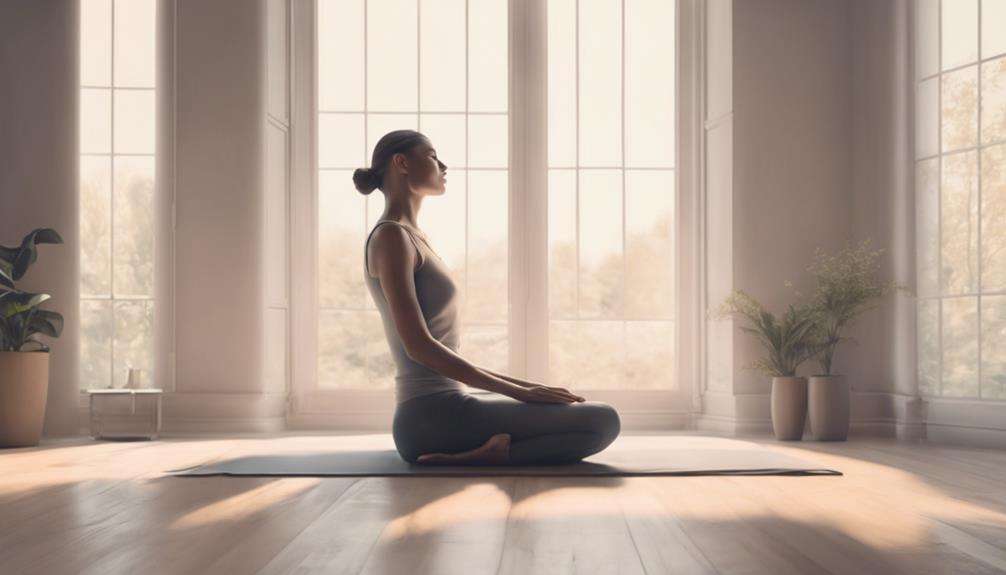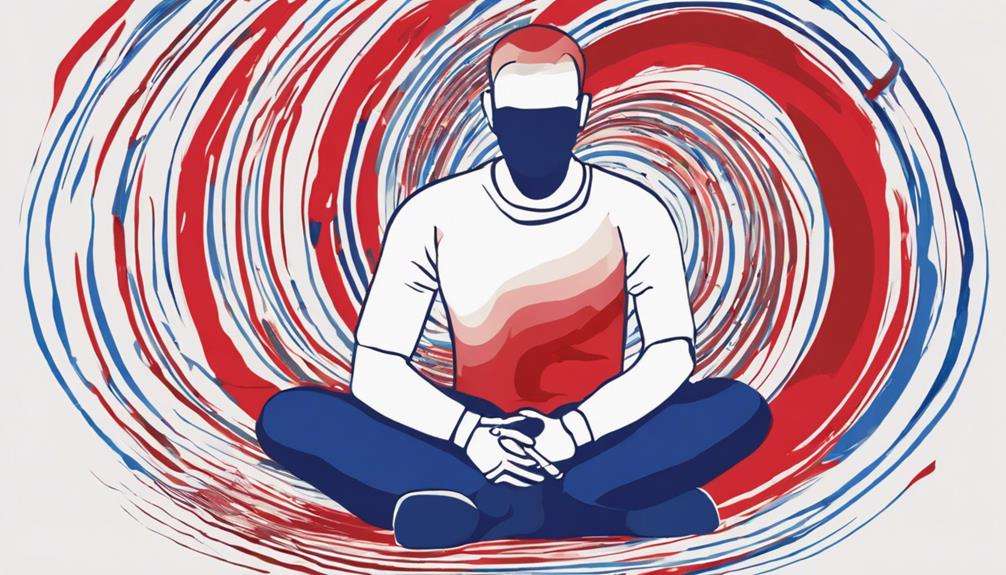Have you ever considered how mind-body techniques could be the key to improving your blood pressure?
By exploring various practices such as yoga, mindfulness meditation, deep breathing, Tai Chi, progressive muscle relaxation, visualization techniques, and biofeedback, you might discover effective ways to manage hypertension and enhance your cardiovascular well-being.
These techniques offer a holistic approach to health that focuses on the mind's influence on the body.
Discover how simple daily practices can impact your blood pressure levels positively and promote overall wellness.
Key Takeaways
- Yoga and meditation lower blood pressure effectively.
- Mindfulness practices aid in stress management and enhance well-being.
- Deep breathing exercises promote relaxation and cardiovascular health.
- Tai Chi and Qi Gong reduce stress hormones and improve circulation.
Yoga for Blood Pressure Control
Have you ever wondered how yoga can effectively help in controlling blood pressure?
Yoga is a powerful mind-body practice that has been shown to reduce blood pressure by activating the body's relaxation response. Through a combination of specific yoga poses, breathing exercises, and meditation techniques, individuals can effectively manage stress, improve cardiovascular health, and ultimately lower their blood pressure readings.
Research indicates that regular yoga practice can lead to reductions in both systolic and diastolic blood pressure levels. In fact, studies have suggested that yoga can be just as effective as medication in lowering high blood pressure.
Mindfulness Meditation Benefits
How can mindfulness meditation benefit individuals seeking to improve their blood pressure control and cardiovascular health?
Mindfulness meditation has been shown to reduce blood pressure and enhance cardiovascular health. Research indicates that engaging in mindfulness meditation can lead to significant decreases in both systolic and diastolic blood pressure levels. By focusing on the present moment without judgment, mindfulness meditation aids in stress management, which in turn can lower blood pressure. Additionally, regular practice of mindfulness meditation has been associated with reduced anxiety, better sleep quality, and overall improved well-being.
Studies even suggest that mindfulness meditation may be as effective as medication in lowering blood pressure for certain individuals. Embracing mindfulness meditation as a part of your routine can offer a powerful tool for improving your cardiovascular health and overall quality of life, serving as a beneficial alternative or complement to traditional medications.
Deep Breathing Techniques for Hypertension

Mindfulness meditation offers a powerful tool for improving cardiovascular health. Moving to the current subtopic of deep breathing techniques for hypertension provides another essential strategy to lower blood pressure and promote relaxation.
Deep breathing techniques can play a critical role in managing hypertension by reducing stress and inducing relaxation. When you engage in controlled deep breathing, you stimulate the parasympathetic nervous system, leading to a decrease in heart rate and blood pressure. By taking slow, deep breaths, briefly holding, and exhaling slowly, you can effectively calm your body and mind, contributing to better blood pressure control.
Research indicates that dedicating just a few minutes a day to practicing deep breathing exercises can have a significant impact on your cardiovascular health. Incorporating deep breathing techniques into your routine can be a simple yet powerful way to enhance your overall well-being and manage hypertension effectively.
Tai Chi and Qi Gong Benefits
Tai Chi and Qi Gong, ancient Chinese mind-body practices, offer significant benefits for improving cardiovascular health and lowering blood pressure through slow movements, meditation, and breathing exercises. These holistic practices have been shown to reduce blood pressure, enhance overall well-being, and improve circulation.
Research indicates that regular practice of Tai Chi and Qi Gong can lead to notable reductions in both systolic and diastolic blood pressure readings. By promoting relaxation and decreasing stress hormones, these techniques provide an effective way to manage blood pressure.
Tai Chi and Qi Gong are accessible to individuals of all ages and fitness levels, making them a gentle yet powerful tool for blood pressure control. Incorporating these practices into your routine can't only benefit your cardiovascular health but also contribute to a sense of calm and well-being. Start exploring the numerous advantages of Tai Chi and Qi Gong today for a healthier tomorrow.
Progressive Muscle Relaxation for BP

Progressive Muscle Relaxation (PMR) is a proven technique that involves the sequential tensing and relaxing of specific muscle groups to help reduce stress and lower blood pressure effectively. By engaging in PMR, you can actively release muscle tension throughout your body, promoting a deep sense of relaxation. Research indicates that PMR isn't only beneficial for reducing stress and anxiety but also plays a significant role in decreasing both systolic and diastolic blood pressure levels.
The systematic process of tensing and then relaxing different muscle groups in PMR helps to enhance your overall well-being. Regular practice of this relaxation technique can lead to improved blood pressure control and contribute to a healthier lifestyle. Integrating PMR into your daily routine is simple and can be done at your convenience. Whether done in the morning to start your day with a sense of calm or in the evening to unwind and destress, PMR offers a valuable tool for managing hypertension and enhancing your quality of life.
Visualization Techniques for Lowering BP
When seeking to lower your blood pressure through visualization techniques, consider the calming imagery benefits that can help ease stress and promote relaxation.
By incorporating breathing exercises into your visualization practice, you can further enhance the relaxation response and potentially reduce your blood pressure levels.
Guided meditation focusing on serene scenes or positive outcomes may aid in calming your mind, leading to improved overall well-being and potentially better blood pressure control.
Calming Imagery Benefits
Utilizing calming imagery and visualization techniques can be instrumental in lowering blood pressure by promoting relaxation and reducing stress levels effectively. Studies have shown that visualizing peaceful scenes or positive outcomes can lead to significant reductions in both systolic and diastolic blood pressure readings. This practice activates the relaxation response in the body, contributing to better cardiovascular health.
Guided imagery sessions focused on relaxation and calmness have proven to be effective in managing high blood pressure. By incorporating calming imagery into your daily routines, you can complement other mind-body techniques aimed at improving blood pressure levels. Embracing these techniques can empower you to take proactive steps towards enhancing your overall well-being and cardiovascular health.
Breathing Exercises Visualization
To enhance the effectiveness of visualization techniques for lowering blood pressure, incorporating deep breathing exercises can amplify the relaxation response and aid in achieving better cardiovascular health outcomes.
Visualization techniques, such as picturing calming images like a tranquil beach or a serene forest, have been shown to reduce stress and contribute to lower blood pressure levels.
When combined with deep breathing exercises, the relaxation effect is further enhanced, leading to a more significant reduction in blood pressure.
Studies suggest that regular practice of visualization exercises, especially when paired with deep breathing, can improve overall well-being and help in the management of blood pressure.
Guided Meditation Relaxation
Enhancing the relaxation response and promoting better cardiovascular health outcomes, incorporating deep breathing exercises with guided meditation relaxation can effectively lower blood pressure. Guided meditation relaxation involves visualization techniques that help reduce systolic and diastolic blood pressure readings.
Regular practice of guided meditation can lead to improved cardiovascular health and reduced stress. Visualization in guided meditation promotes relaxation, decreases anxiety, and enhances overall well-being.
Research indicates that guided meditation relaxation is effective in managing high blood pressure and fostering mental clarity. By incorporating guided meditation into your routine, you can't only lower elevated blood pressure but also experience the benefits of stress reduction, relaxation, and improved cardiovascular health.
Biofeedback for Blood Pressure Management
When utilizing biofeedback for blood pressure management, you can actively monitor and adjust your physiological responses to promote better control over your blood pressure levels. Biofeedback is a technique that provides real-time feedback on physiological processes, such as blood pressure, allowing individuals to make conscious changes to lower it. By using biofeedback, you can learn to regulate your responses, leading to reduced stress, anxiety, and hypertension. Studies have shown that consistent practice of biofeedback can result in significant reductions in blood pressure levels over time.
Through biofeedback training, you can acquire the skills needed to manage your blood pressure effectively. By receiving immediate feedback on your body's responses, you can learn how to make adjustments that positively impact your blood pressure. This technique empowers you to take control of your physiological processes and work towards achieving better blood pressure regulation. Embracing biofeedback as part of your blood pressure management strategy can contribute to improved overall health and well-being.
Frequently Asked Questions
What Are the Mind Body Exercises to Lower Blood Pressure?
To lower blood pressure with mind-body exercises, try meditation techniques, breathing exercises, yoga poses, mindfulness practices, stress reduction methods, relaxation responses, guided imagery, body awareness, and progressive muscle relaxation. Incorporating these practices into your daily routine can be beneficial.
How Can I Mentally Control My Blood Pressure?
To mentally control your blood pressure, practice stress management techniques like breathing exercises, meditation, and visualization. Stay mindful and use biofeedback training for relaxation response. Consider cognitive restructuring and guided imagery to manage your blood pressure effectively.
What Are the Techniques for Lowering Blood Pressure?
To lower blood pressure, practice various techniques like breathing exercises, meditation, yoga, stress management, mindfulness practices, guided imagery, progressive relaxation, biofeedback therapy, and hypnotherapy. These methods can help you relax and improve your blood pressure levels.
What Relaxation Techniques Bring Blood Pressure Down?
To bring your blood pressure down, try incorporating deep breathing, progressive relaxation, guided imagery, biofeedback training, meditation practice, yoga poses, tai chi movements, visualization exercises, and mindful walking into your routine. These techniques can lead to significant improvements.
Conclusion
To sum up, incorporating mind-body techniques into your daily routine can have a profound impact on lowering your blood pressure and improving your overall cardiovascular health. By practicing yoga, mindfulness meditation, deep breathing, Tai Chi, Qi Gong, progressive muscle relaxation, visualization, and biofeedback, you can achieve significant reductions in your blood pressure levels.
These techniques offer a natural, drug-free way to manage hypertension and promote a sense of calm and well-being. Give them a try and watch your blood pressure drop like a rock!






